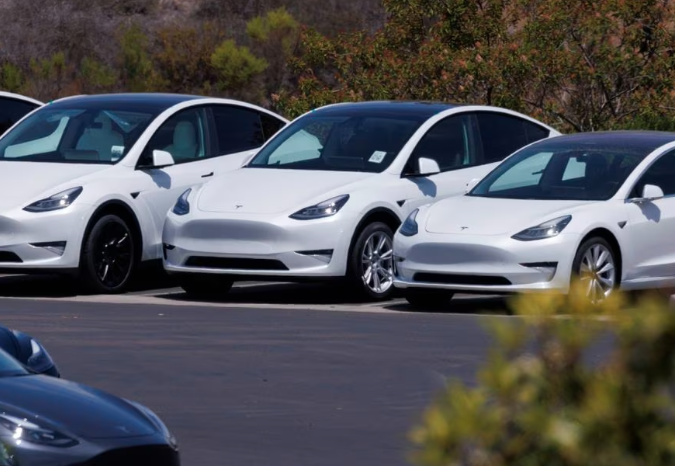Air pollution is one of the most pressing global challenges that affects lives worldwide. In many countries, severe air pollution is still one of the most crucial burdens of economic development (Jayachandran 2009, Greenstone and Hanna 2014, Chen et al. 2013, Greenstone and Jack 2015, Jack 2017, Ito and Zhang 2020, Khanna et al. 2021, Neidell et al. 2022, Gao et al. 2022, Berkouwer and Dean 2022). Previous studies have linked air pollution with negative health outcomes, such as low fertility rates and increased mortality.
A fundamental challenge in curbing air pollution is its transboundary nature. International organisations including the World Bank recognise the international spillover effects of air pollution as a first-order problem (World Bank 2022). However, the economics literature has not incorporated this spillover effect when evaluating the cost of air pollution and the benefit of environmental regulation. For example, the benefits of recent ambitious environmental policies in China and India may have a substantial impact on environmental quality in the surrounding countries, but these spillovers are not typically considered while evaluating these policies.
Our study
In our paper, we study the international spillover effects of air pollution and examine the extent to which conventional economic analysis would understate the cost of air pollution as well as the benefit of environmental regulation (Heo, Ito and Kotamarthi 2023). Our framework integrates recent advances in atmospheric science into econometric estimation and microdata on mortality and health. We use the Hybrid Single-Particle Lagrangian Integrated Trajectory model (HYSPLIT) to obtain data on hourly particle trajectories from China to South Korea. Combining these particle trajectory data with hourly PM2.5 data in China and Korea, we estimate how the transboundary PM2.5 from China affects PM2.5 in South Korea. We then connect these data with the universe of individual-level mortality data and emergency-department-visit data in South Korea to quantify the mortality and health impacts of transboundary air pollution.
Geographical characteristics of South Korea and China
In East Asia, autumn and winter are characterised by prevailing west winds (‘the Westerlies’), which mean that South Korea receives persistent west winds from China. In these seasons, we find that PM2.5 is substantially higher in the northwest region of South Korea than in the southeast region. By contrast, these regions have similar PM2.5 levels in spring and summer.
We use HYSPLIT to quantitatively confirm this relationship by simulating hourly backward trajectories from China to South Korea. The northwestern cities in South Korea, such as Incheon and Seoul, have trajectories coming from China more than half of the time in our sample period. By contrast, cities in the southeast, such as Busan, experience trajectories from China at a lower frequency.
Figure 1 PM2.5 in China and South Korea
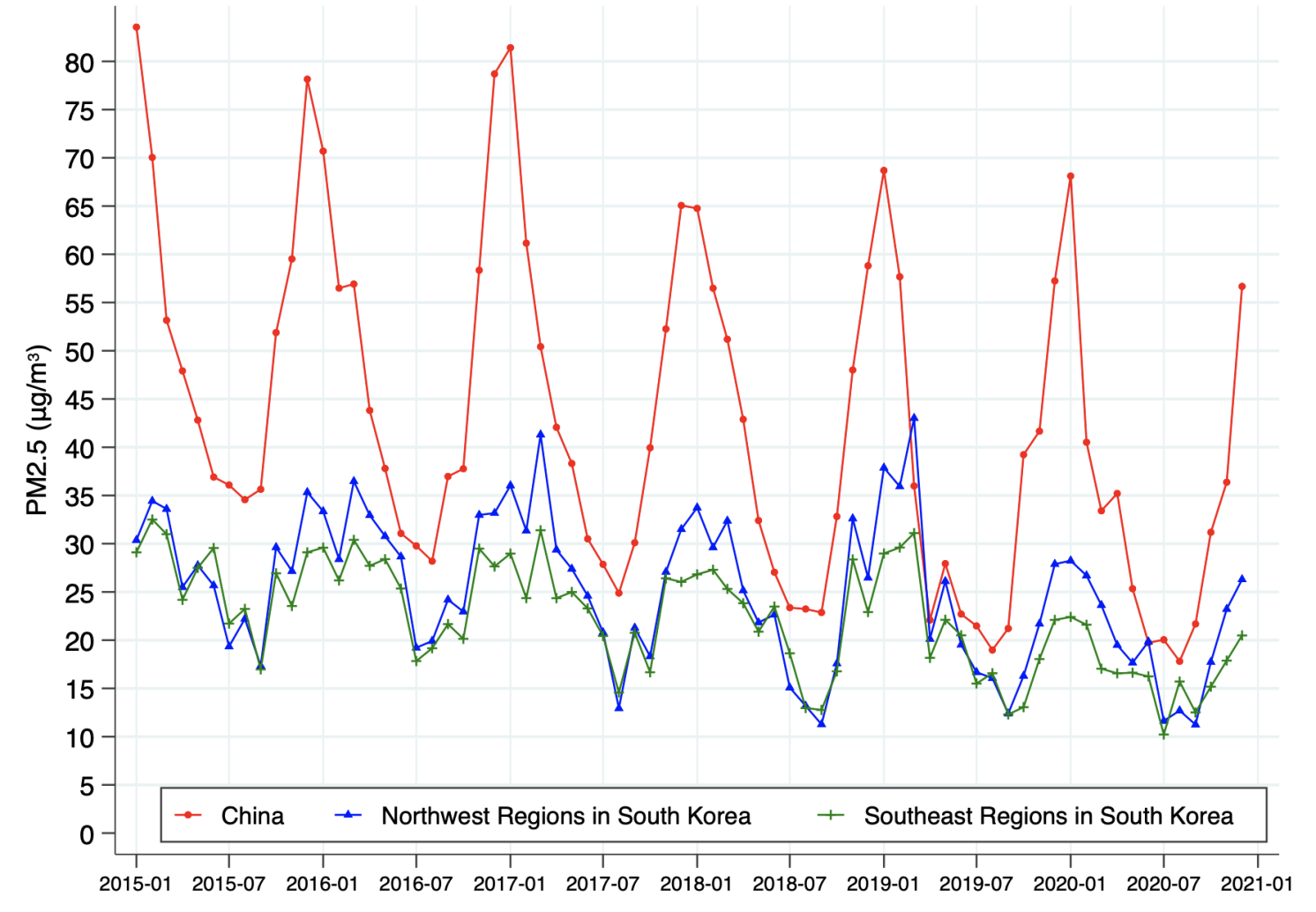

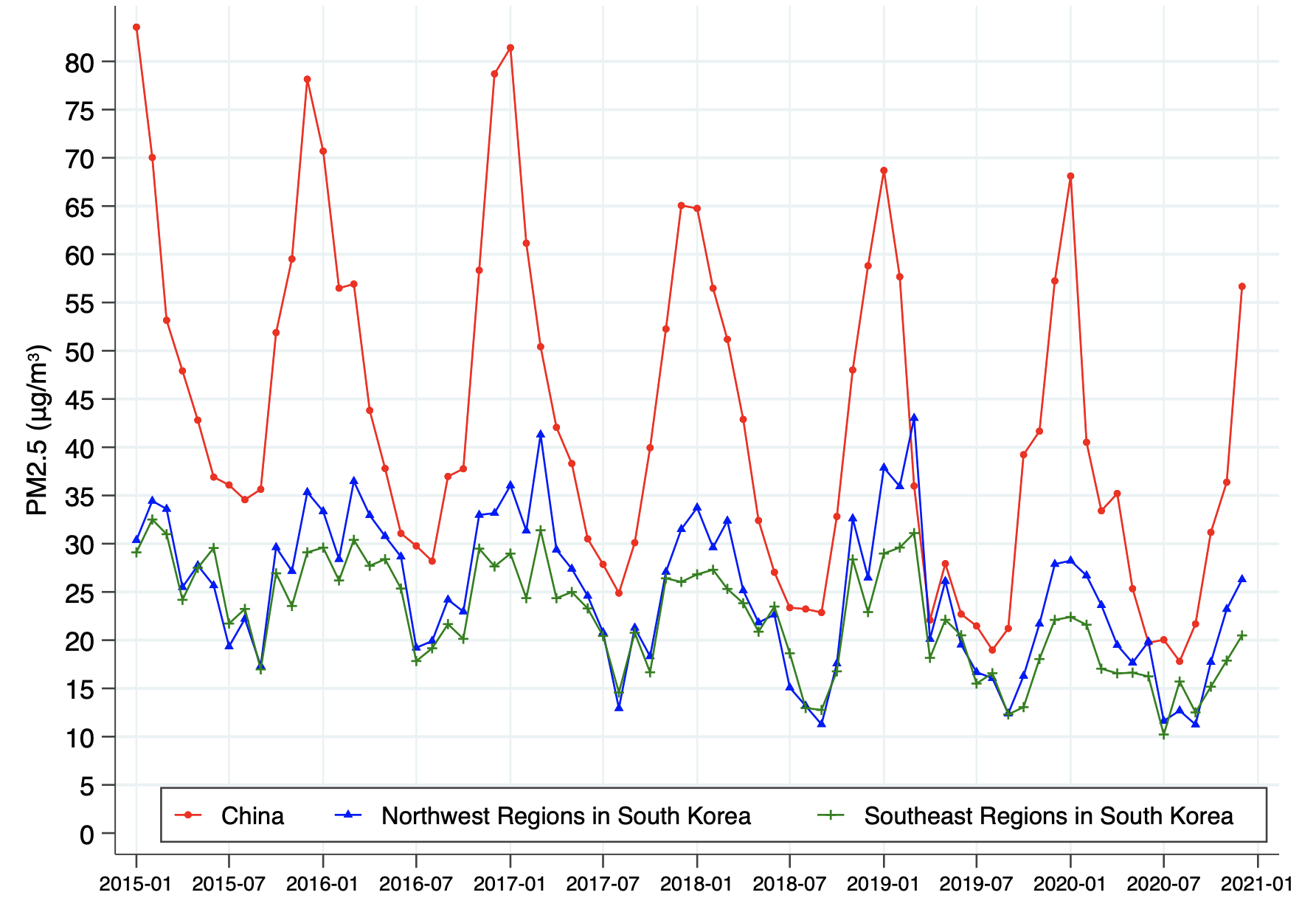

Figure 2 Examples of backward trajectories
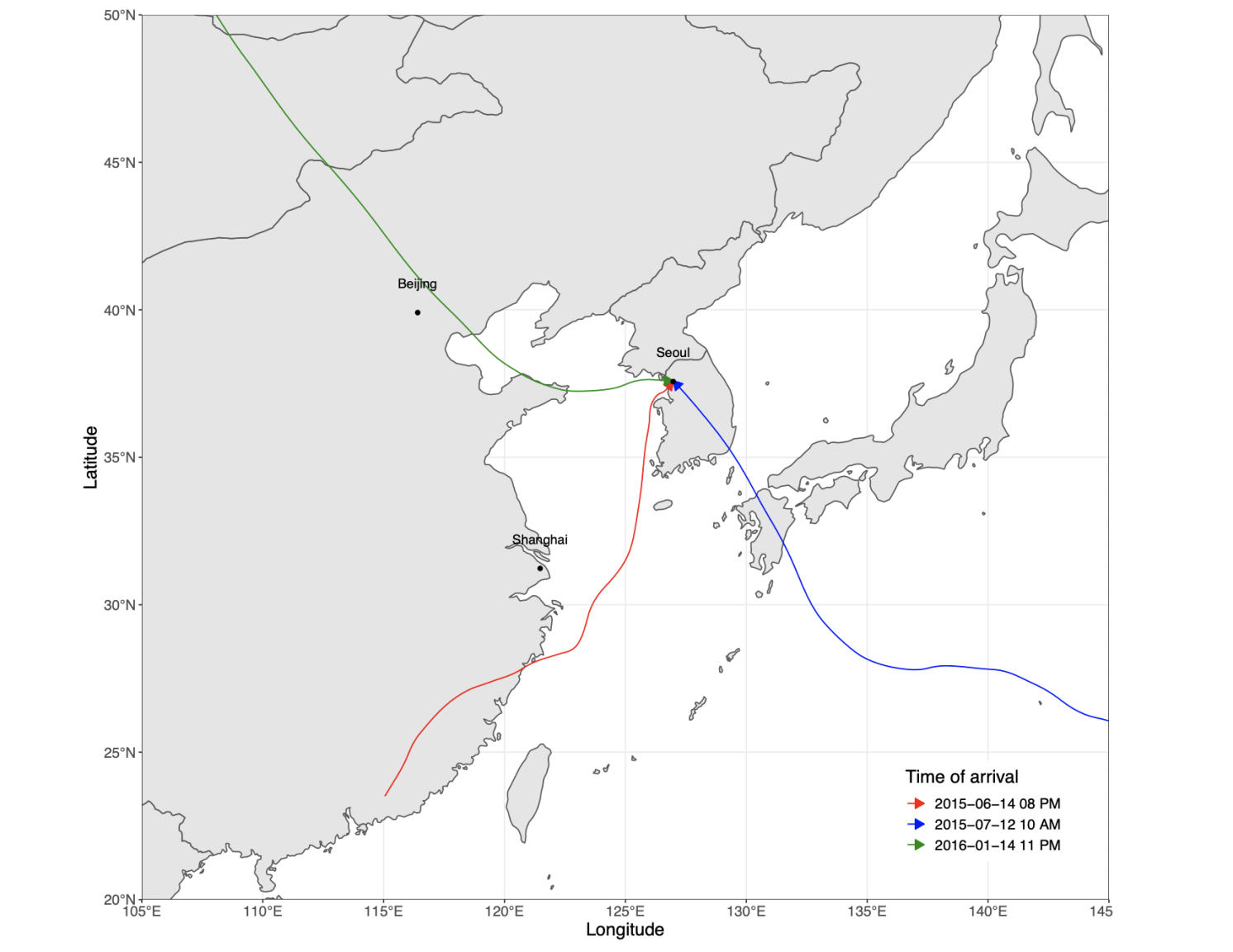

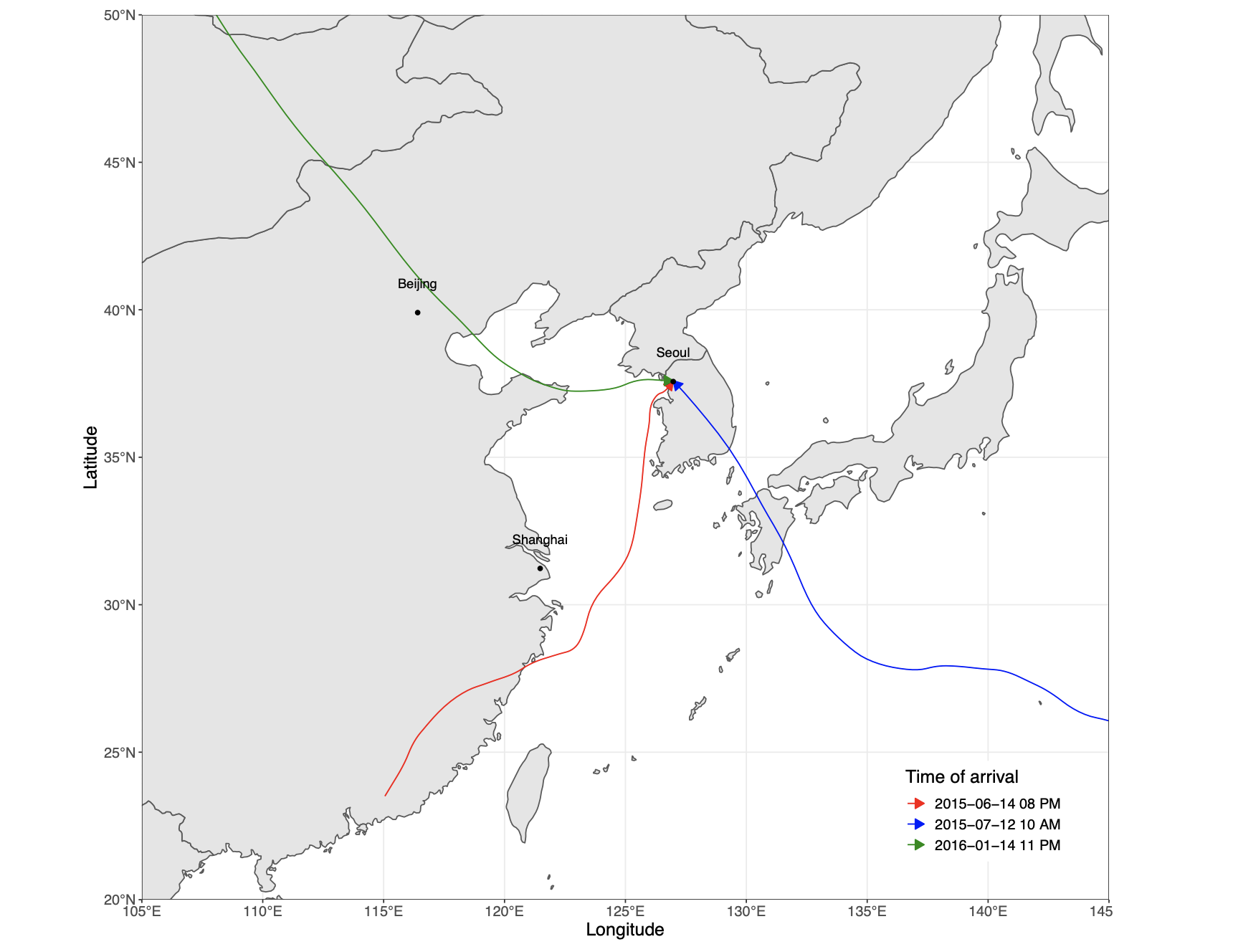

Notes: This figure shows three examples of the backward trajectories obtained from HYSPLIT. For example, the green trajectory came from northern China, passed through Beijing, and reached Seoul at 11 pm on 14 January 2016.
Figure 3 Frequency of trajectories coming from China
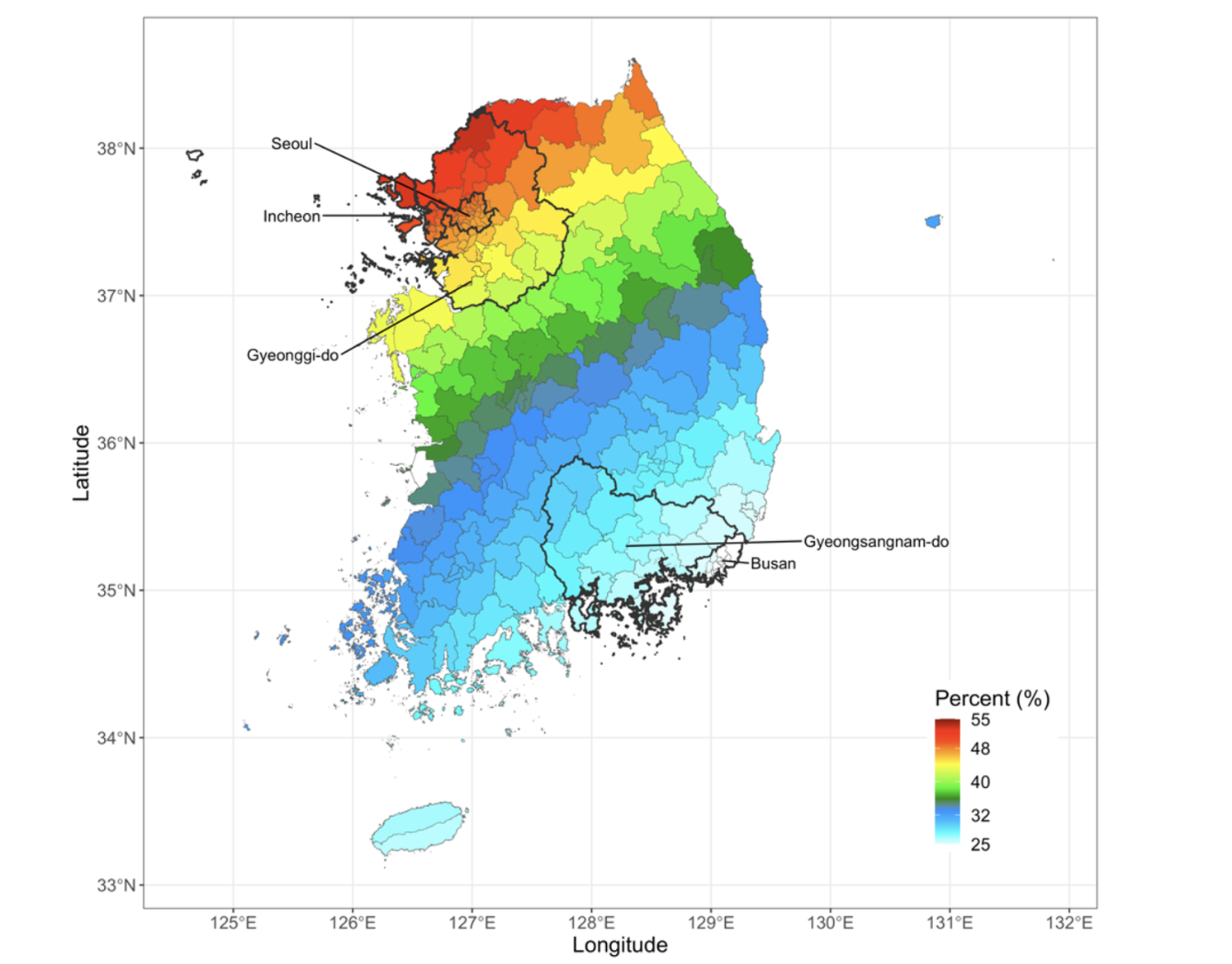

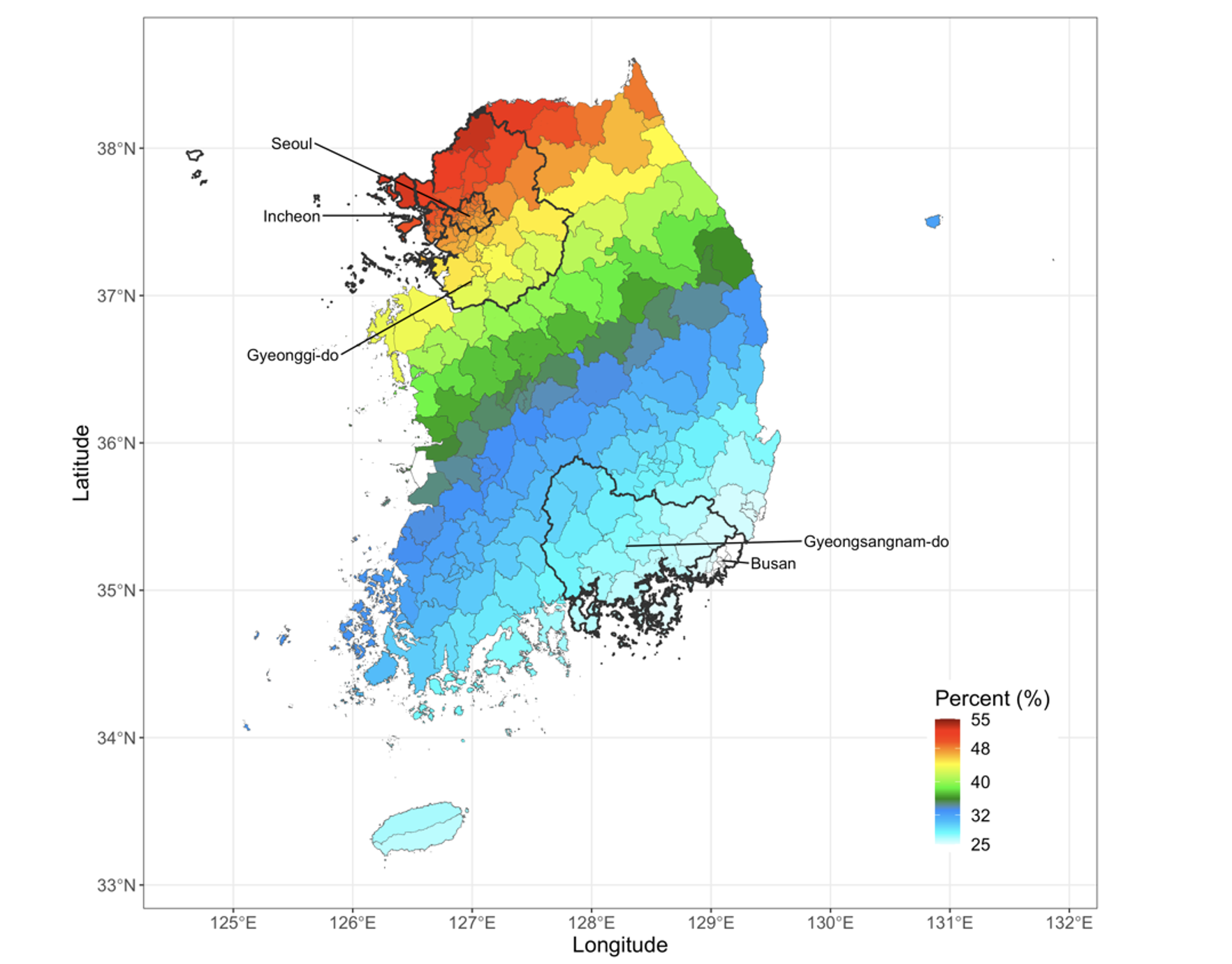

What are the international spillover effects of air pollution?
We statistically estimate this relationship by regressing the hourly PM2.5 in South Korean cities on the hourly transboundary PM2.5 from China to each city. We find that, on average, a 1 μg/m3 increase in transboundary PM2.5 from China results in a 0.122 μg/m3 increase in PM2.5 in South Korean cities. Combining these data with the universe of individual-level mortality data, we estimate the mortality impact of transboundary air pollution. Our estimates indicate that a 1 μg/m3 increase in transboundary PM2.5 from China in the past 70 days results in an increase in annual mortality in South Korea by 31.2 per million people, which is a 0.6% increase in mortality relative to the baseline mortality rate for this population.
Figure 4 Scatter plot of PM2.5 in South Korea and transboundary PM2.5 from China
Panel A) Raw data
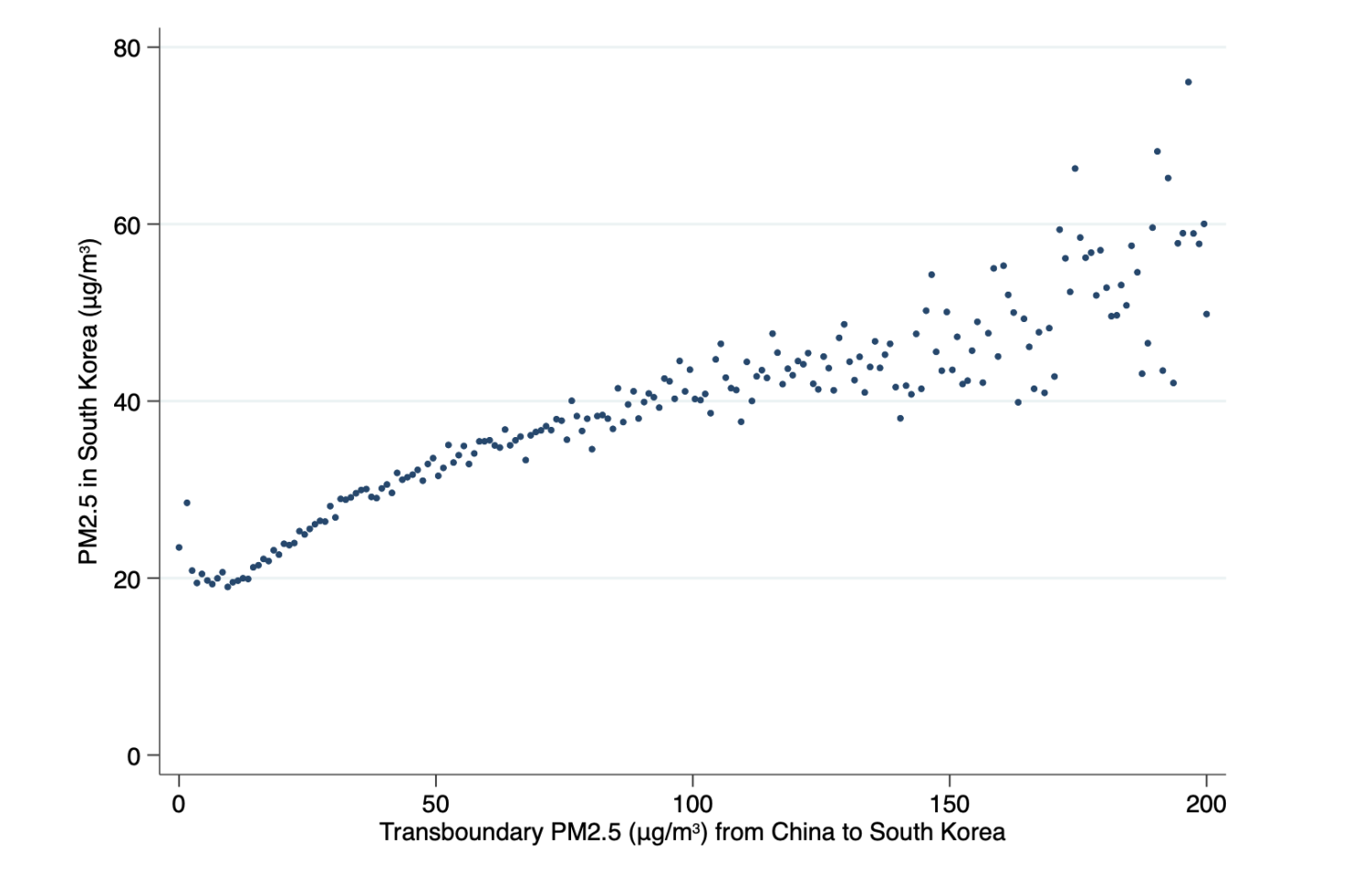



Panel B) Residuals
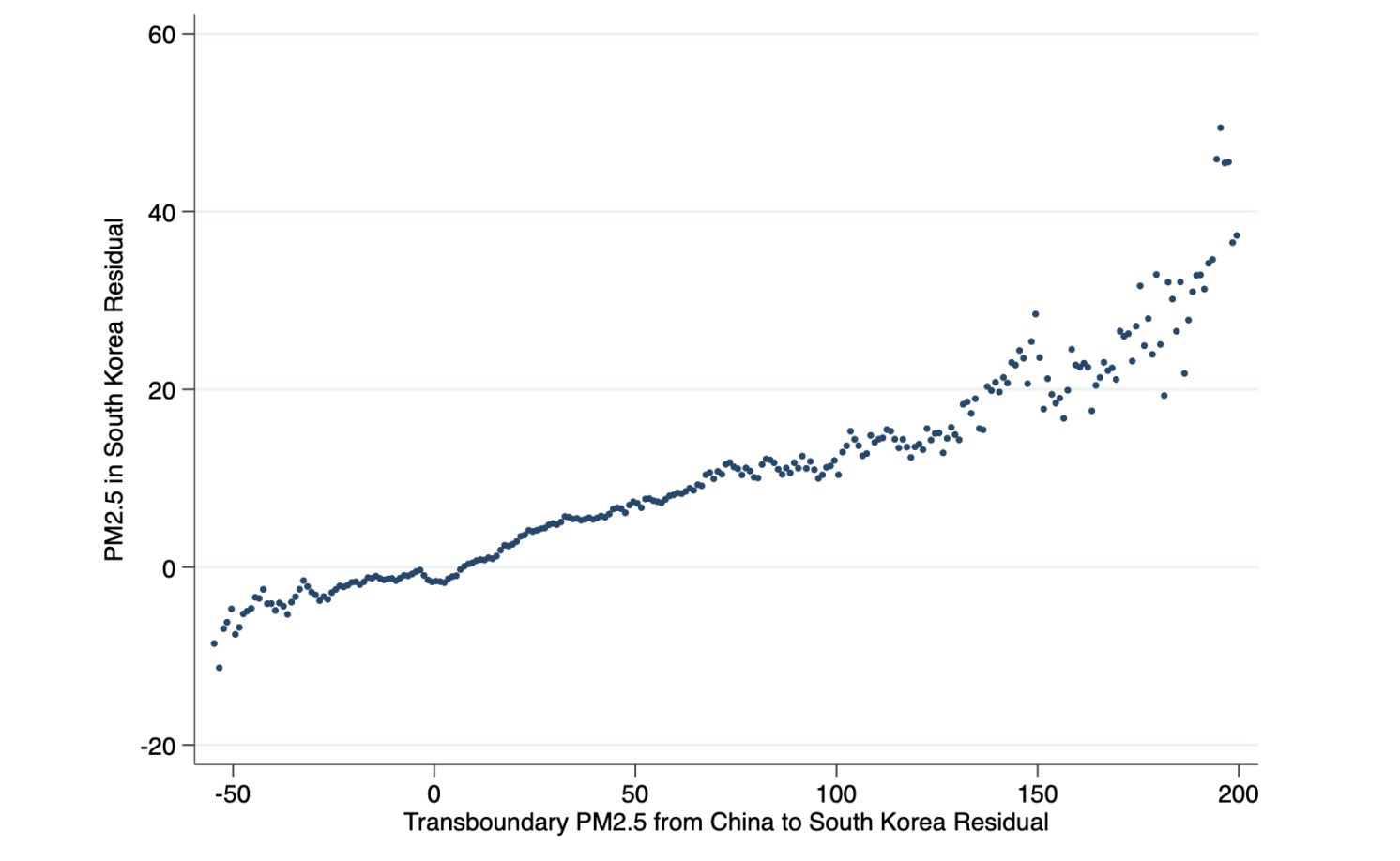

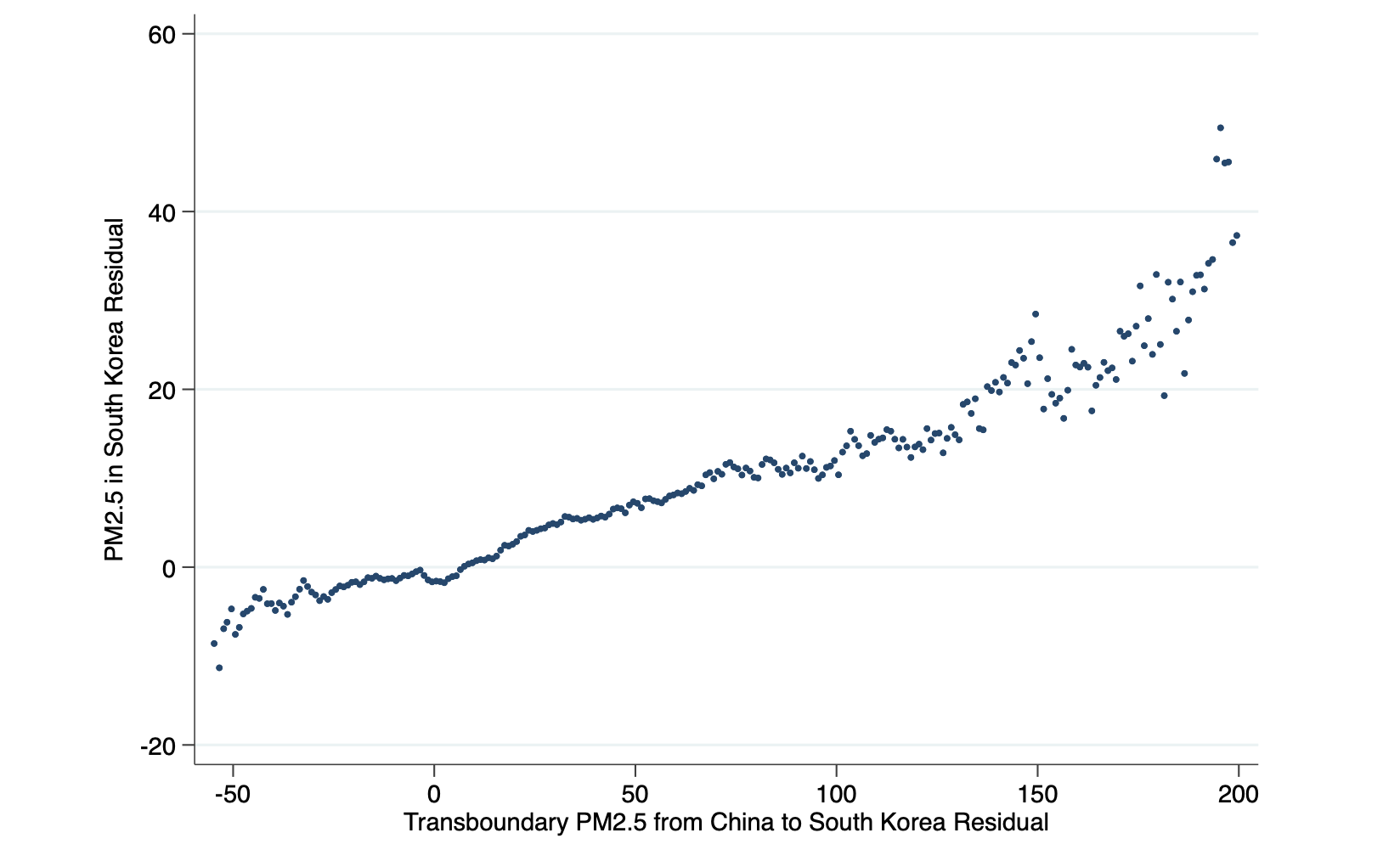

Figure 5 Weekly lagged effects of the transboundary air pollution on mortality


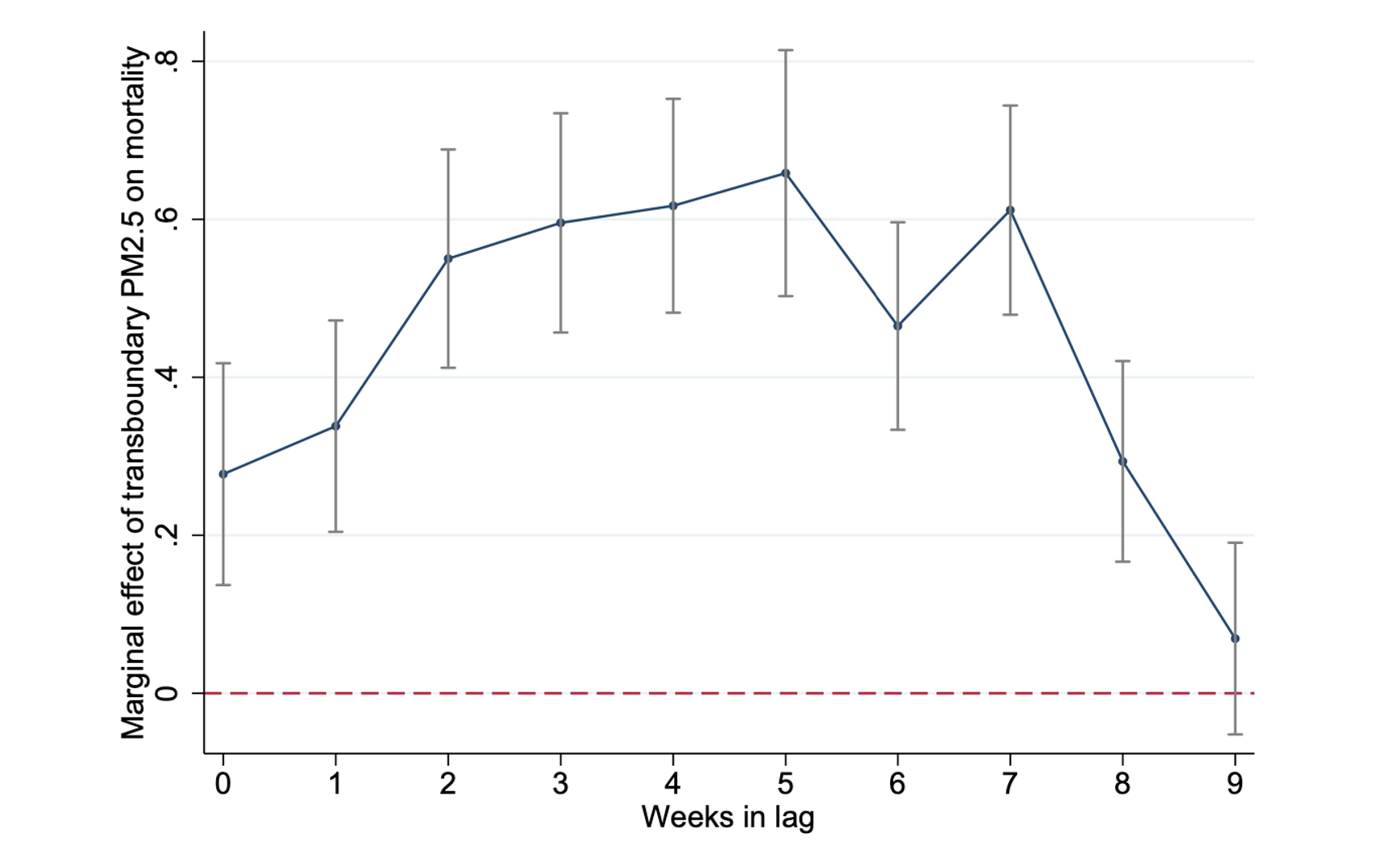

In addition to the mortality impact on the overall population, we also estimate the impact on the elderly and infants, and those with respiratory and cardiovascular diseases as the cause of death. The marginal effect on mortality is higher for infants and those with respiratory and cardiovascular diseases as the cause of death. Our analysis also suggests that both the contemporaneous and lagged transboundary PM2.5 affect mortality, although the lagged effects diminish after 70 days.
Using the transboundary PM2.5 from China as an instrumental variable for the local PM2.5 in South Korea, we also identify the effect of PM2.5 on mortality in South Korea. Our estimates indicate that a 1 μg/m3 increase in PM2.5 from China in the past 70 days results in an increase in annual mortality by 79.7 per million people for the overall population, which is a 1.5% increase in mortality relative to the mean. The marginal effect as a per cent increase in mortality is larger for infants and those with respiratory and cardiovascular diseases as the cause of death.
Besides the impact on mortality, air pollution could also increase morbidity (Barwick et al. 2018). In particular, the short- and medium-run increases in air pollution are believed to affect the acute symptoms of asthma and rhinitis (Eguiluz-Gracia et al. 2020, Kuiper et al. 2021). Thus, the increase in transboundary PM2.5 from China to South Korea may increase such symptoms in the South Korean population.
To investigate this, we collected data on the universe of emergency-department visits in South Korea between 2013 and 2017 for patients who received medical treatment in the emergency department for atopic dermatitis, rhinitis, or asthma. We find that transboundary PM2.5 results in increased emergency department visits for asthma and rhinitis but not for atopic dermatitis.
What does it mean to our policymakers?
Our findings suggest that transboundary air pollution from China has a substantial impact on mortality and morbidity in South Korea. While a country’s environmental regulations may have international spillover effects on other countries, these effects have not been incorporated in the conventional cost-benefit analysis of environmental regulations in the economics literature.
To highlight this point, we consider an implication of a prominent environmental policy recently implemented in China known as ‘the war on pollution’. The Chinese government rolled out a nationwide air-pollution reduction programme in 2014. Our data suggest that PM2.5 in China had a long-run decline during our sample period. Our data also show that this reduction resulted in a decline in transboundary PM2.5 from China to South Korea: transboundary PM2.5 from China to South Korea declined by 9.63 μg/m3 during our sample period from 2015 to 2019.
Using our estimates and the value of a statistical life for South Korea, we find that a 9.63 μg/m3 reduction in transboundary PM2.5 from China to South Korea implies a spillover benefit of $2.62 billion per year for South Korea, based on the avoided mortality. This suggests that the international spillover benefits of environmental regulation are economically substantial.
Strategic reduction in air pollution
For water pollution, several previous studies find that a county or local government may take advantage of the spillovers of water pollution and strategically allocate the flow of the pollution in transboundary rivers (Sigman 2002, Lipscomb and Mobarak 2016, Wang and Wang 2021, He et al. 2020). To the best of our knowledge, such strategic allocation of pollution has not yet been investigated for air pollution.
In theory, it is possible to observe such a phenomenon for air pollution. If China made such a strategic decision in the war on pollution, China may have primarily focused on reducing air pollution more for its citizens and less for those who live in other countries, thus potentially lowering the potential international spillover benefits.
We indeed find empirical evidence of China’s strategic reductions in air pollution during the war on pollution. During our sample period, the reduction in PM2.5 in Chinese cities from which most air pollution has gone outside the national border is lower than the nationwide average reduction and much lower than the reduction in Chinese cities from which most air pollution has remained within China.
This strategic pollution reduction implies that the international spillover benefits, which our analysis revealed, may have been lower than a counterfactual scenario in which such a strategic decision was absent: the additional international spillover benefit of the war on pollution could have been up to $2.36 billion per year for South Korea.
Source : Voxue





